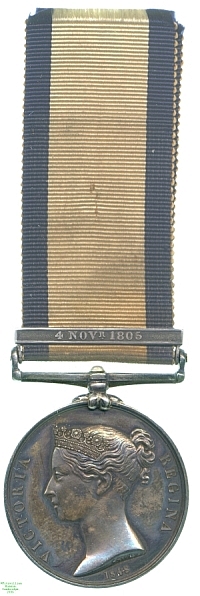
Obverse, a bust of Queen Victoria

Reverse, Britannia with a trident seated sideways on a seahorse

Obverse, a bust of Queen Victoria |

Reverse, Britannia with a trident seated sideways on a seahorse |
Just as in 1848 the extensive land campaigns of the Napoleonic Wars and the other conflicts of the pre-Victorian era were recognised by the issue of the Military General Service Medal, those serving in the Navy at the time were recognised with the Naval General Service Medal. As with the Army equivalent and the East India Company's related award, many of the battles for which the medal was awarded had been fought so long ago that few if any claimants survived.
In addition, bars were awarded for many actions whose significance and size were, despite the heroism displayed by those involved, relatively minor. The result was that many of the bars were issued in tiny numbers, with some combinations all but unique, and the medals command a very high price among collectors because of this rarity and individuality. This in turn, along with the manufacture in most cases of more bars than were eventually issued, has led to the `improvement' of many common awards where recipients' names are shared with those present at `rarer' battles. The medal also shares with the Military General Service and Army of India Medals the oddity that Queen Victoria, whose portrait they bear, was not the ruler under whom the battles for which it was awarded were fought.
In the immediate aftermath of the Battle of Trafalgar the French and Spanish ships that were not captured in the action escaped in small groups; some returned to Cadiz under the command of the mortally wounded Spanish Amiral Gravina, but a division of four French battleships under Arrière-Admiral Pierre le Pelley put out into the Atlantic instead. Two weeks later, on 4 November 1805, they were caught off Cadiz, in Ortegal Bay, by a British squadron of four ships of the line and four frigates under Rear-Admiral Sir Richard Strachan. In the resulting Battle of Cape Ortegal all four French ships were captured.
This medal was awarded to Lieutenant John Reynolds of the 48-gun frigate HMS Santa Margarita; his service aboard her has been verified. Lester Watson purchased the medal at some point before 1928.